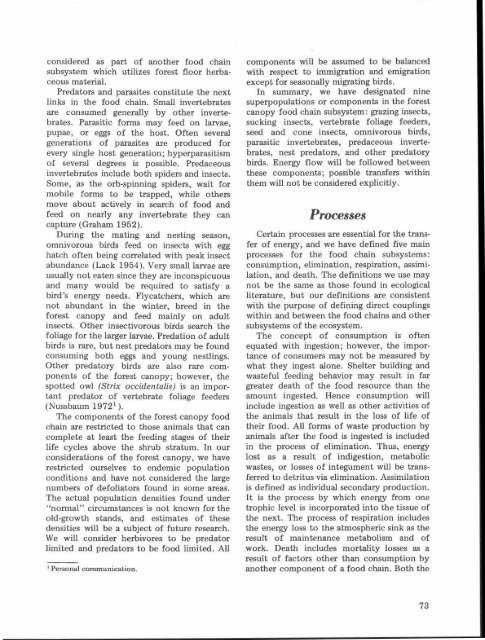PE EIE[R-Rg RESEARCH ON - HJ Andrews Experimental Forest
PE EIE[R-Rg RESEARCH ON - HJ Andrews Experimental Forest
PE EIE[R-Rg RESEARCH ON - HJ Andrews Experimental Forest
Create successful ePaper yourself
Turn your PDF publications into a flip-book with our unique Google optimized e-Paper software.
considered as part of another food chai n<br />
subsystem which utilizes forest floor herbaceous<br />
material .<br />
Predators and parasites constitute the nex t<br />
links in the food chain . Small invertebrate s<br />
are consumed generally by other invertebrates<br />
. Parasitic forms may feed on larvae ,<br />
pupae, or eggs of the host . Often several<br />
generations of parasites are produced for<br />
every single host generation ; hyperparasitis m<br />
of several degrees is possible. Predaceous<br />
invertebrates include both spiders and insects .<br />
Some, as the orb-spinning spiders, wait fo r<br />
mobile forms to be trapped, while other s<br />
move about actively in search of food an d<br />
feed on nearly any invertebrate they ca n<br />
capture (Graham 1952) .<br />
During the mating and nesting season ,<br />
omnivorous birds feed on insects with eg g<br />
hatch often being correlated with peak insec t<br />
abundance (Lack 1954) . Very small larvae are<br />
usually not eaten since they are inconspicuou s<br />
and many would be required to satisfy a<br />
bird 's energy needs . Flycatchers, which ar e<br />
not abundant in the winter, breed in the<br />
forest canopy and feed mainly on adult<br />
insects . Other insectivorous birds search th e<br />
foliage for the larger larvae . Predation of adult<br />
birds is rare, but nest predators may be foun d<br />
consuming both eggs and young nestlings .<br />
Other predatory birds are also rare components<br />
of the forest canopy ; however, th e<br />
spotted owl (Strix occidentalis) is an important<br />
predator of vertebrate foliage feeder s<br />
(Nussbaum 1972 1 ) .<br />
The components of the forest canopy food<br />
chain are restricted to those animals that ca n<br />
complete at least the feeding stages of their<br />
life cycles above the shrub stratum. In our<br />
considerations of the forest canopy, we hav e<br />
restricted ourselves to endemic population<br />
conditions and have not considered the larg e<br />
numbers of defoliators found in some areas .<br />
The actual population densities found under<br />
"normal" circumstances is not known for th e<br />
old-growth stands, and estimates of thes e<br />
densities will be a subject of future research .<br />
We will consider herbivores to be predator<br />
limited and predators to be food limited . All<br />
' Personal communication .<br />
components will be assumed to be balanced<br />
with respect to immigration and emigration<br />
except for seasonally migrating birds .<br />
In summary, we have designated nine<br />
superpopulations or components in the forest<br />
canopy food chain subsystem : grazing insects ,<br />
sucking insects, vertebrate foliage feeders ,<br />
seed and cone insects, omnivorous birds ,<br />
parasitic invertebrates, predaceous invertebrates,<br />
nest predators, and other predator y<br />
birds. Energy flow will be followed between<br />
these components ; possible transfers within<br />
them will not be considered explicitly .<br />
Processes<br />
Certain processes are essential for the transfer<br />
of energy, and we have defined five main<br />
processes for the food chain subsystems :<br />
consumption, elimination, respiration, assimilation,<br />
and death . The definitions we use may<br />
not be the same as those found in ecologica l<br />
literature, but our definitions are consistent<br />
with the purpose of defining direct couplings<br />
within and between the food chains and other<br />
subsystems of the ecosystem .<br />
The concept of consumption is often<br />
equated with ingestion ; however, the importance<br />
of consumers may not be measured by<br />
what they ingest alone . Shelter building an d<br />
wasteful feeding behavior may result in fa r<br />
greater death of the food resource than th e<br />
amount ingested. Hence consumption wil l<br />
include ingestion as well as other activities o f<br />
the animals that result in the loss of life o f<br />
their food. All forms of waste production b y<br />
animals after the food is ingested is include d<br />
in the process of elimination . Thus, energ y<br />
lost as a result of indigestion, metaboli c<br />
wastes, or losses of integument will be transferred<br />
to detritus via elimination. Assimilatio n<br />
is defined as individual secondary production .<br />
It is the process by which energy from on e<br />
trophic level is incorporated into the tissue of<br />
the next. The process of respiration include s<br />
the energy loss to the atmospheric sink as th e<br />
result of maintenance metabolism and o f<br />
work. Death includes mortality losses as a<br />
result of factors other than consumption b y<br />
another component of a food chain. Both the<br />
73








